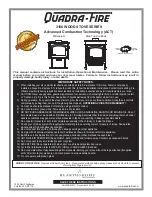
Vermont Castings • Encore Model 2040-CAT-C Owner’s Manual_R7 • 2019 - ___ • 06/22
10
8390-204C
NOTE:
It will take several minutes after closing the bypass
damper for the temperature probe to fully adjust to the new
temperature. If the probe indicator is below the operate
catalyst range, add fuel or open the bypass damper to allow
the fire to further build before engaging the catalyst again.
If the probe indicator is above the operate catalyst range,
the catalytic combustor is running too hot and may be
damaged. In many cases, decreasing the primary air can
reduce the catalyst temperature and adding less wood with
each loading can also help if overheating is persistent. Do
not add wood to the stove if the probe reads above the
operate catalyst range.
Avoid using a full load of very dry wood in the firebox, such
as dry slab wood or wood with below 14% moisture content.
This may result in continuous very high temperatures in the
secondary combustion area and damage the combustor.
Never burn treated wood, garbage, solvents or trash. All of
these may poison the catalyst and prevent it from operating
properly. Never burn cardboard or loose paper except for
kindling purposes. Never burn coal; doing so can produce
soot or large flakes of char or fly ash that can coat the
combustor and cause smoke to spill into the room. Coal
smoke can also poison the catalyst so that it won’t operate
properly.
NOTE:
The catalytic combustor is fragile and will crack if
subjected to thermal shock. Thermal shock can occur when
refueling with wet wood or closing the bypass damper too
early after refueling.
For best results when refueling, wear long-cuffed stove
gloves to protect your hands and forearms.
Reloading a hot stove:
When a wood load is added to a hot bed of coals (continuous
use), open the bypass damper and either the top or front
loading doors. Stir the hot coals to allow ash to fall through
the grate. Hot coals should then be pushed against the rear
wall and leveled depending on the amount of coals. Add
fresh wood and close the loading door and bypass damper.
If the coals are glowing and hot, it is possible to set the air
control to any setting immediately after loading the stove.
Reloading a warm stove:
If the stove is relatively cold (for instance after a long
overnight burn), the coal bed may need to be re-energized
prior to adding a large load of wood. Open the bypass damper
and either the top or front loading door. Stir the coals to
allow ash to fall through the grate. Push the remaining coals
toward the rear wall. Close the door(s) and bypass damper
and set the primary air to the highest position. Allow the
coals to re-ignite and heat the system for 10 to 15 minutes.
Once the coals are glowing, a fresh batch of wood may be
added following the “hot stove” procedure above.
A proper bed of coals is critical to the performance of the
Encore stove. The rear refractory wall of the stove should
be almost entirely white in color with proper operation. This
indicates the combustion system is running at a proper
elevated temperature. If the rear wall is black with creosote
or develops a dark brown color, it is likely that the coal bed
is not sufficiency large enough or hot enough. Revisit the
above instructions and adjust the amount of kindling or time
at high air settings to get the system hotter. Wood size or
excessive moisture may also cause lower than desirable
stove temperatures.
While not required, operating your stove with the catalytic
combustor installed creates optimum conditions for
secondary combustion and will increase your efficiency up
to 15% on low burn, making sure you get the most heat out
of each load of wood.
The catalytic element is a metal “honeycomb” coated
with the catalytic material. The element sits at the bottom
of the secondary combustion chamber. Smoke, gases
and particulates that are not fully combusted during the
secondary combustion process pass through the catalyst,
creating a tertiary burn. This results in higher efficiency and
lower emissions.
The catalyst will initiate combustion of smoke and particulates
at 500° - 600°F (260° - 315°C), half the temperature normally
required for unaided secondary combustion. If you followed
the startup operation steps in the previous section the stove
will be sufficiently hot to allow the combustor to work. Once
the combustor starts working, heat generated by burning
the smoke will keep it working.
To determine whether the combustor is operating, refer to
the temperature probe which shows the operating range of
the catalytic combustor. This is located on the back of the
stove and is viewed from the top.











































